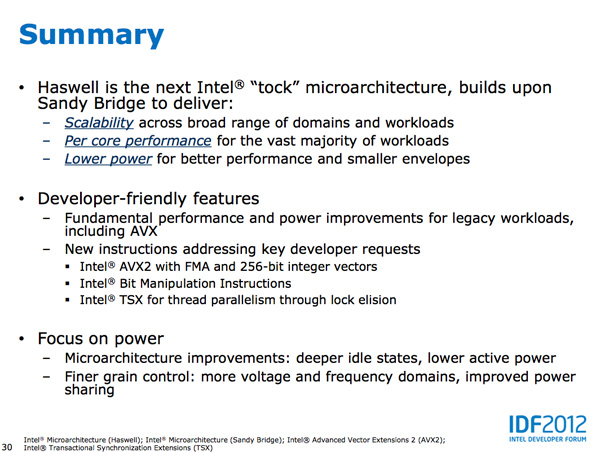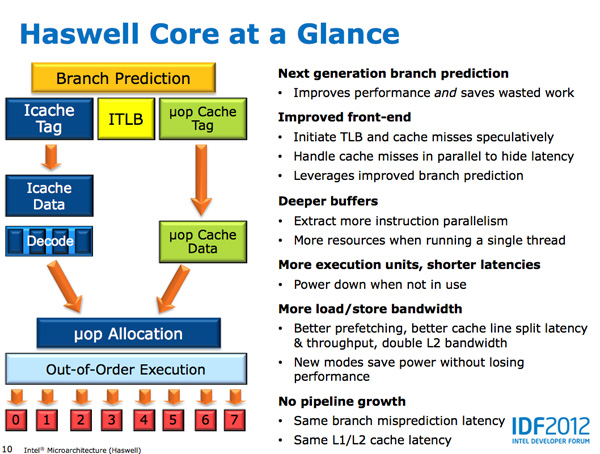Intel's Haswell Architecture Analyzed: Building a New PC and a New Intel
by Anand Lal Shimpi on October 5, 2012 2:45 AM ESTFinal Words
After the show many seemed to feel like Intel short changed us at this year's IDF when it came to architecture details and disclosures. The problem is perspective. Shortly after I returned home from the show I heard an interesting comparison: Intel detailed quite a bit about an architecture that wouldn't be shipping for another 9 months, while Apple wouldn't say a thing about an SoC that was shipping in a week. That's probably an extreme comparison given that Apple has no motivation to share details about A6 (yet), but even if you compare Intel's openness at IDF to the rest of the chip makers we cover - there's a striking contrast. We'll always want more from Intel at IDF, but I do hope that we won't see a retreat as the rest of the industry seems to be ok with non-disclosure as standard practice.
There are three conclusions that have to be made when it comes to Haswell: its CPU architecture, its platform architecture and what it means for Intel's future. Two of the three look good from my perspective. The third one is not so clear.
Intel's execution has been relentless since 2006. That's over half a decade of iterating architectures, as promised, roughly once a year. Little, big, little, big, process, architecture, process, architecture, over and over again. It's a combination of great execution on the architecture side combined with great enabling by Intel's manufacturing group. Haswell will continue to carry the torch in this regard.
The Haswell micro-architecture focuses primarily on widening the execution engine that has been with us, moderately changed, for the past several years. Increasing data structures and buffers inside the processor helps to feed the beast, as does a tremendous increase in cache bandwidth. Support for new instructions in AVX2 via Intel's TSX should also pave the way for some big performance gains going forward. Power consumption is also a serious target for Haswell given that it must improve performance without dramatically increasing TDP. There will be slight TDP increases across the board for traditional form factors, while ultra portables will obviously shift to lower TDPs. Idle power drops while active power should obviously be higher than Ivy Bridge.
You can expect CPU performance to increase by around 5 - 15% at the same clock speed as Ivy Bridge. Graphics performance will see a far larger boost (at least in the high-end GT3 configuration) of up to 2x vs. Intel's HD 4000 in a standard voltage/TDP system. GPU performance in Ultrabooks will increase by up to 30% over HD 4000.
As a desktop or notebook microprocessor, Haswell looks very good. The architecture remains focused and delivers a sensible set of improvements over its predecessor.
As a platform, Haswell looks awesome. While the standard Haswell parts won't drive platform power down considerably, the new Haswell U/ULT parts will. Intel is promising a greater than 20x reduction in platform idle power and it's planning on delivering it by focusing its power reduction efforts beyond Intel manufactured components. Haswell Ultrabooks and tablets will have Intel's influence in many (most?) of the components placed on the motherboard. And honestly, this is something Intel (or one of its OEMs) should have done long ago. Driving down platform power is a problem that extends beyond the CPU or chipset, and it's one that requires a holistic solution. With Haswell, Intel appears committed to delivering that solution. It's not for purely altruistic reasons, but for the survival of the PC. I remember talking to Vivek about an iPad as a notebook replacement piece he was doing a while back. The biggest advantage the iPad offered over a notebook in his eyes? Battery life. Even for light workloads today's most power efficient ultraportable notebooks can't touch a good ARM based tablet. Haswell U/ULT's significant reduction in platform power is intended to fix that. I don't know that we'll get to 10+ hours of battery life on a single charge, but we should be much better off than we are today.
Connected standby is coming to PCs and it's a truly necessary addition. Haswell's support of active idle states (S0ix) is a game changer for the way portable PCs work. The bigger concern is whether or not the OEMs and ISVs will do their best to really take advantage of what Haswell offers. I know one will, but will the rest? Intel's increasingly hands on approach to OEM relations seems to be its way of ensuring we'll see Haswell live up to its potential.
Haswell, on paper, appears to do everything Intel needs to evolve the mobile PC platform. What's unclear is how far down the TDP stack Intel will be able to take the architecture. Intel seems to believe that TDPs below 8W are attainable, but it's too early to tell just how low Haswell can go. It's more than likely that Intel knows and just doesn't want to share at this point. I don't believe we'll see fanless Haswell designs, but Broadwell is another story entirely.
There's no diagram for where we go from here. Intel originally claimed that Atom would service an expanded range of TDPs all the way up to 10W. With Core architectures dipping below 10W, I do wonder if that slide was a bit of misdirection. I wonder if, instead, the real goal is to drive Core well into Atom territory. If Intel wants to solve its ARM problem, that would appear to be a very good solution.












245 Comments
View All Comments
lmcd - Saturday, October 6, 2012 - link
Interestingly, this might be the first chance in forever AMD has at competing with Intel. If Haswell's sole goal is to hit lower power targets, and Piledriver hits its 15% and Steamroller its 15% over that, AMD is suddenly right up with Intel's i5 series with its GPU-less chips, and upper i3-range with their APUs, which is absolutely perfect positioning: most i5 purchases are for people planning to pair with discrete graphics, while most i3 series seem to go to the PC buyer looking for low price tags.The one downside is that the i7 series is Intel's money-maker: the clueless people who think they're getting maximum performance but are really just feeding the binning system and buying an unbalanced PC.
milkod2001 - Sunday, October 7, 2012 - link
u got it wrong bro, Intels money maker is not i7, it's i3 and i5(low end and a bit of mainstreem)as for Haswell, on paper it looks too good to be true as Ivy did last year and ended up everything but impressive.
Since Intel conroe core(2006) there actually were not any significant improvements worth mentioning.There's not much extra what todays CPUs can do and Pentium4 could not a decade ago.
I would love to see some innovations user could really benefit from(something like reattachable,thin, light, portable, firm solar panel hooked at the back of screen or even build in as last layer into screen itself) and not that crap Intel/AMD gives us year by year.
xeizo - Sunday, October 7, 2012 - link
Anand is very right, it's everything about power savings which in effect makes smaller and more portable form factors possible!As for mainstream perfomance, my Linux workstation still uses a Q9450 rev. C1 from 2008 clocked at 3.2GHz and a SSD of course. That box feels in every way as snappy as my Windows-box with Sandy Bridge at 4.8GHz. Which means, I really didn't need more performance than what C2Q already gave. Of course the SB-box benchmarks much faster, about twice as fast in most things, but the point is for myself I really don't need that perfromance except for some occasional game.
But I could use a smaller, cooler running device instead!
Teknobug - Tuesday, October 16, 2012 - link
LOL my Linux system still runs a Sempron and it's still fast.oomjcv - Sunday, October 7, 2012 - link
Very interesting article, enjoyed reading it.Something I would like to see is a decent comparison between Intel's and AMD's plans. Many might be able to outline the basics, but a thorough article on the subject should be rather enlightening... Comparing their design philosophies, architectures, possible pitfalls and successes etc, pretty much what's been done with this article only with both companies.
I know it might be time consuming but I imagine it could be quite a nice read.
zwillx - Monday, January 21, 2013 - link
agreed; it's difficult to find the common ground with so many different chip architectures. x86 is a big enough competition but now it's getting split wide open with ARM and BIG/litle etc etc so it's always helpful to have either more charts or real world examples lol.My take from this article though: Haswell still won't have the prowess to beat the GT650. I have GTX660 in my laptop w/ Optimus (TM). It works. Runs a game on HD4000 at 17 FPS. On the GTX660 I get 100+ fps, and am able to use higher anti-aliasing settings. So, clearly a 100% improvement over Ivy bridge is only putting the chip into "mediocre" category by the time its released.
alexandrio - Sunday, October 7, 2012 - link
"The bigger concern is whether or not the OEMs and ISVs will do their best to really take advantage of what Haswell offers. I know one will, but will the rest?"I am curious who is that one OME that will do their best to really take advantage of Haswell offers?
zwillx - Monday, January 21, 2013 - link
Apple. Or are you joking. I personally hate Apple and have since the original iMac but their engineering is top notch when it comes to getting ideal performance from silicon to user. So.. guessing that's the reference.Silma - Monday, October 8, 2012 - link
A fine read, technically very comprehensive, but still overly melodramatic.While it is true that it is crucial for Intel to step a foot in the byod market some things still hold true:
- In value and profit the PC processor market is much bigger than the byod processor market and will stay so for years because PCs, especially business PCs won't disappear anytime soon.
- Nobody can touch Intel in this market, it has been proved for decades. Not AMD at the height of its success, not mighty IBM, not Sun, nobody.
- Contrary to what you say Intel has a definitive production advantage and there are very few fabs able to compete. Note that Apple is incapable of producing processors, it is dependent on external manufacturers.
- What Apple does with its processor is interesting business wise for its iPods/Pads/Phones, but Apple doesn't have the research power Intel and others have in the chip space and I can't see how it will innovate better than Intel and other competitors.
- Intel is aware of its shortcomings, is pushing tremendously in the right direction. A competitor that doesn't rest on its laurels is a mighty threat, ARM beware.
- If Apple stops using Intel processors, it will of course wipe a few hundred millions of Intel's turnover but won't be anything remotely dangerous for Intel
- It remains to be seen that Apple users will accept yet another platform change.
- It remains to be seen that it would make sense business-wise for Apple
- I am quite sure many phone companies will be open about renewed chip competition and not letting a single platform become too powerful.
All in all it seems to me Intel is as dangerous as ever, executing very well in its core business and heading towards great things in the phone/pad space.
johnsmith9875 - Thursday, October 11, 2012 - link
Why couldn't they at least stick to LGA2011?